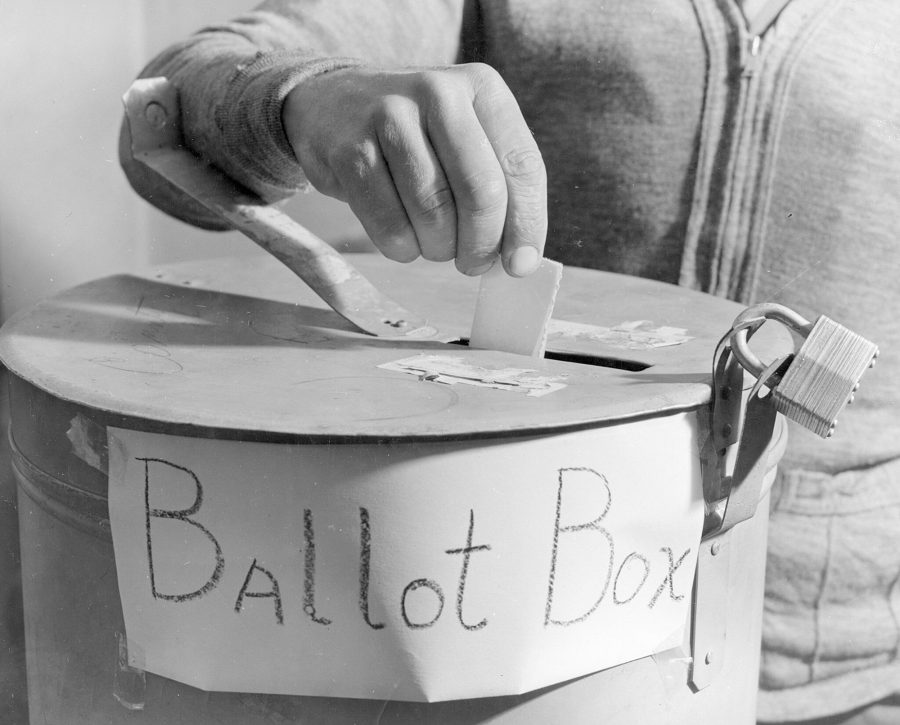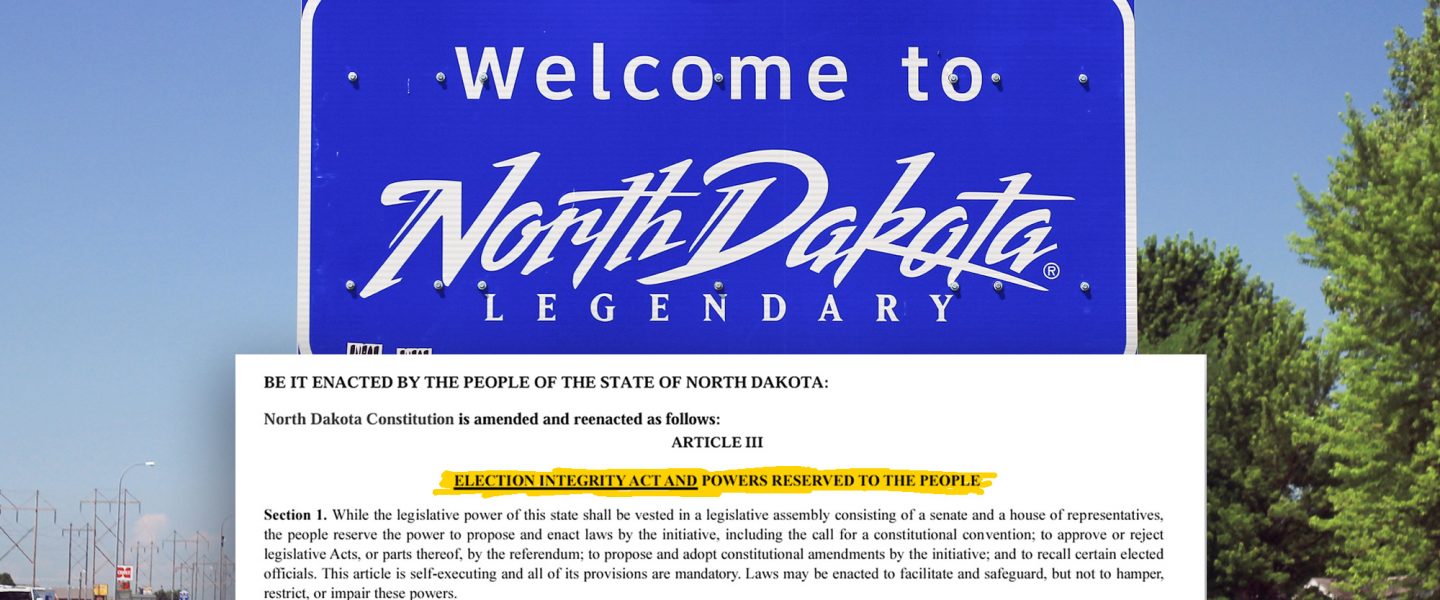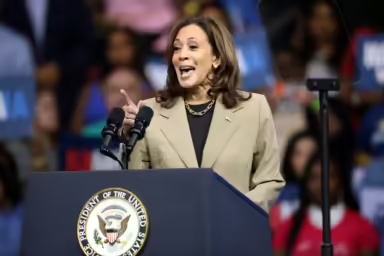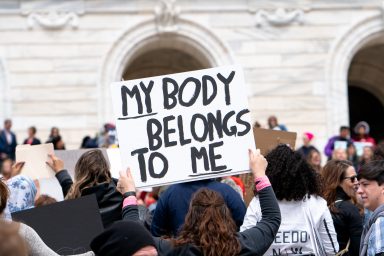This activist’s package of controversial measures are rooted in Trump’s Big Lie. Do any of them make sense?
|
Listen To This Story
|
In a radical reform under the banner of “election integrity,” a new proposed ballot measure would mandate that all ballots in North Dakota elections be counted by hand. Lydia Gessele of Chaseley, ND — a self-styled stay-at-home mom, home-schooler, crafter, and anti-trans advocate — is leading the grassroots effort to get the Election Integrity Act initiative added to the small red state’s June 2024 ballot.
On December 13, Gessele and her supporters presented a petition to North Dakota Secretary of State Michael Howe (R) for language approval. This step is required before petitioners are permitted to start collecting signatures for their ballot measure.
Geselle’s initiative is an omnibus tour de force of election reform. In addition to the hand count mandate, the measure to be put to the voters contains a number of other major proposed changes in the conduct of the state’s elections.
- It would put tight new restrictions on mail-in balloting. There would be an allowance for absentee ballots only for voters “who request one for a specific election in writing within a reasonable time period prior to Election Day.” Otherwise, mail-in ballots would be prohibited.
- It would mandate that all in-person voting take place on Election Day. Early voting would be prohibited.
- It would prohibit the use of popular unsupervised (i.e., curbside or lobby) ballot drop boxes.
These new restrictions take aim at a recent trend that saw 44 percent of North Dakotans opting to participate in early voting or voting by mail during the 2020 election.
Another controversial component of this omnibus set of reforms would eliminate tribal government-issued IDs and long-term care IDs from the types of identification voters can present at the polls.
Non-acceptance of tribal IDs has long been a tactic used to suppress the Native American vote. Many Native Americans and Alaskan Natives live on tribal lands in rural communities that do not have residential addresses. Because of this, many Native Americans do not have an ID that matches state voter rolls. These voters also frequently encounter the problem of having their votes invalidated by virtue of being cast in the wrong precinct.
The elderly may already face added logistical hurdles to voting, including the difficulty if not impossibility of obtaining a driver’s license or other acceptable ID. For those residing in long-term care facilities, a long-term care certificate would greatly ease those burdens.
US elections already suffer from turnout levels well below those of most established democracies, and even relatively minor-seeming impediments have been shown to reduce them still further. And the impact has been shown to be greater among certain groups, including those most marginalized. Strict voter ID laws tend to disenfranchise voters of color, the elderly, the poor, people with disabilities, rural residents, and college-age adults. Some of the reasons for this are:
- Millions of Americans do not have government-issued photo ID.
- Obtaining an ID often entails significant time and expense, as may securing the documents needed for that purpose.
- An individual may have to travel to procure a voter ID, which can be particularly onerous to the elderly, people with disabilities, individuals with no access to a vehicle or public transportation, and people residing in rural communities.
In terms of the nuts and bolts of election administration, the measure would require all elections to be run by elected rather than appointed county auditors. This is not likely to sit well with the many North Dakota counties whose auditors are currently appointed by a county commission. Critics of this reform, who see it as something of a solution in search of a problem, point to an unnecessary politicization of administrative positions as well as an increased risk that the elected auditors’ expertise is insufficient to perform the required duties of the office.
To make matters worse, nowhere in the text of the measure is the term “audit” defined or any indication given of what type or scale of post-election procedures are intended or indeed permitted.
Perhaps the most bizarre provision in Gessele’s measure declares that all elections shall, upon request, be audited by qualified electors (i.e., voters) of the state or citizens of the United States. That is, any of America’s roughly 318 million citizens (there appears to be no age requirement) would be free to come into North Dakota to audit an election. This conjures up images of a new breed of Cyber Ninjas roaming North Dakota on the prowl for an election to audit.
While post-election audits can operate to bolster election security and deter fraud, we need look no further than that now-defunct Florida-based outfit’s “audit” of Maricopa County, AZ, in 2021 to conclude that an audit free-for-all risks post-election chaos rather than instilling confidence and certainty.
To make matters worse, nowhere in the text of the measure is the term “audit” defined or any indication given of what type or scale of post-election procedures are intended or indeed permitted.
It is not clear why Gessele’s group eschews establishing some species of well-defined and well-regulated in-state audit protocol, as adopted by states such as Colorado, in favor of this Wild-West approach. If election security is the goal of the petitioners, then this measure would appear to be at best a counterproductive means to that end.
Not an Isolated Push
The North Dakota reform proposal is part of the groundswell movement from activists in Republican-governed states and counties who are swayed by former President Donald Trump’s unsupported claims that the 2020 election was rigged and that he, not Joe Biden, should be in the White House. In 2023, at least seven additional states — Kansas, Missouri, Montana, South Carolina, Texas, Arizona, and Virginia — introduced legislation that would ban the use of vote counting machines, though none of the bills have yet become law.
Meanwhile, some county boards have been approving their own proposals to require hand counts. In Arizona, the Cochise County Board of Supervisors adopted a proposal to conduct hand count audits for all of the county’s early vote ballots for the 2022 election. This despite warnings from their county attorney, who informed them that their proposal was illegal. As a result, the Arizona Alliance of Retired Americans and a Democratic voter filed a lawsuit challenging the proposal. On November 7, a judge ruled the county may not conduct a hand count audit of early ballots.
According to Gessele, the majority of the measure was written by her associate Paul Sorum, a perennial North Dakota gubernatorial candidate and gadfly. He is a former Tea Party member and in 2012 the party endorsed Sorum in the governor’s race.
Having led a petition drive to indict then-Gov. Jack Dalrymple (R) on bribery charges (Dalrymple’s “crime” was accepting campaign contributions from the oil industry; the petition failed for insufficiency of signatures), Sorum then proceeded to emulate Trump eight years before Stop the Steal, suing on the basis of a technical glitch to get 97 percent of the votes thrown out and himself declared governor with less than 2 percent of the vote. Which worked out for him about as well as Jerry Lundegaard’s scheme in the movie Fargo.

Rage Against the Machine
In the background of the move to ditch all the vote counting computers is Fox News’s $788 million settlement with Dominion Voting Systems over the network’s claims that Dominion’s machines were rigged to produce a Biden win. Though Dominion fought back successfully against a conspiracy theory that was never able to to adduce any damning evidence, the rage on the MAGA Right over the supposed electronic rigging has never abated, and continues to be stoked by Trump and his minions, if not so much by a chastened Fox.
One upshot are the proposals for hand-count-only elections popping up where MAGAs hold sway.
Claiming that hand counts are the only way to accurately generate election results is also a tool being used to spread disinformation about the use of voting machines. Verified Voting states:
Calls to eliminate vote counting machines disregard the safeguards election officials can use to ensure the security and accuracy of voting technology…
While hand counts are necessary for checking election outcomes in audits and recounts, widespread expansion of hand counting would impair election administration and undermine public confidence in US elections.
Gessele and her supporters said that they were motivated by issues they claim occurred in 2022, including inaccurate ballot scanners and an electrical outage that prevented people in Bismarck from voting. But Republican officials are among those pushing back against the hand count mandate proposal.
Former Secretary of State Al Jaeger, a Republican who oversaw North Dakota’s elections for 30 years through 2022, rejected Gessele’s claims, saying, “There was nothing that took place that would have changed the outcome of a vote. Nothing at all.”
Current Secretary of State Howe also opposes the measure, asserting that hand counts are less standardized than using scanners.
Howe likened it to having a computer rather than a human umpire at a baseball game. “When you hand-count, you bring in the human element of umpiring. You could have a wide strike zone, you could have a narrow strike zone,” he said. “What you get with a machine is one consistent strike zone every single time.”
Long-time election integrity advocate Jonathan Simon (a senior editor at WhoWhatWhy) saw the challenge somewhat differently, offering a nuanced view:
It is true that, ballot by ballot, the computer is likely to be less error prone. It doesn’t get tired or bleary-eyed late at night after hours of counting.
But there is another side to this coin, a counterargument that pre-Stop the Steal election integrity advocates made for 20 years: With computer counts, especially in the absence of effective hand-count audits, the programmers — or hackers — can, in Howe’s terms, set the “strike zone” just about anywhere they please, and move it around to suit their partisan purposes. And the resulting mistabulation of votes will very likely go undetected.
So there is in fact a rational basis for either hand counting or robust auditing. Unintentional human counting errors, unlike intentional computer programming or hacking exploits, tend to go in both directions and wind up effectively a wash, when you look at the overall political big picture. The concern with computers is less about error and more, much more, about fraud. To be blunt, computers, inadequately secured and audited, can generate outcome-determinative rigs and alter the political balance of power.
Long before 2020 and Stop the Steal, there was expert consensus on that point — the existence of vulnerabilities to fraud — but no one at the adult table would touch the proposition, backed by a good deal of data and pattern analysis, that the computers had been involved in actually producing a fraudulent election. Until Trump — who weaponized “election integrity” with bad intent but was basically right about the susceptibility of the process to fraud.
But once someone so prominent (Trump) came out and alleged actual fraud, the whole system, courts included, went on the defensive, and circled the wagons around our wonderful computers and perfect elections.
Simon concluded by addressing the problematic nature of hand counting in the current political environment:
The biggest problem with hand counting right now is that everyone is so divided, tribal, and politically hostile that the necessary bipartisan human-to-human cooperation to conduct a successful hand count may well be, in some places at least, an impossible fantasy (check your guns at the door, please!).
So it is debatable whether adopting a hand-count-only system would work as an elixir to heal the partisan divide that exists in this country, or instead only exacerbate the problem and lead to more distrust and potential violence (even audits, as we saw with Maricopa and the Cyber Ninjas in 2021, can be problematic).
But perhaps that speaks to the value of giving it a try in a state like North Dakota, where — let’s face it — the results are essentially not in doubt (red) and of little national impact. It might actually make a good laboratory to establish whether hand counting, perhaps limited to the relatively few federal and statewide contests, can work at all in the cauldron of US elections.
The deadline to file a ballot measure for North Dakota’s June 11, 2024, election is midnight on February 12. We will continue to track this and other proposed reforms throughout the year.
This is the first article in a series on state-level threats to our democratic system. A goal of the series is to determine the extent to which these individual “reforms” are part of a more centralized effort to make our country less democratic. Along the way, we will also try to highlight individuals and groups who are working in a positive way to combat election disinformation and voter suppression — and show why that work is of such vital importance.




